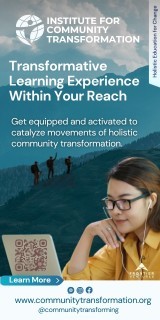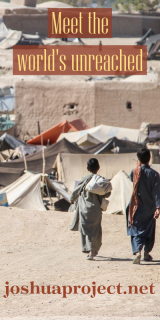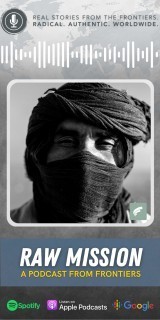The PEACE Plan in Rwanda
Global Missions Partnership Process that Empowers and Transforms

The efforts of Saddleback Church and the PEACE plan (http://www.thepeaceplan.com) in Rwanda under the leadership of pastor Rick Warren is relatively well-known and has been widely reported in the secular and religious press since its inception in 2005. Likewise the phenomena of Short Term Mission going forth from Saddleback Church (more than a thousand STMers to Rwanda alone) have also been the subject of much discussion.
However, there is a story within the story, a story of trial and error as a new kind of partnership is in the process of being forged, a partnership in which the partners are striving to honor diversity and wrestling with the reality of globalization and what appropriate models of leadership can look like that will enable the church to fulfill the Great Commission and the Great Commandment. It is the unfolding story of the integration of national aspiration using cultural appropriateness calibrated by the biblical mandate of being the Body of Christ where every member needs the other.
How It Started
In 2004 President Kagame invited Pastor Rick Warren to implement his newly-announced P.E.A.C.E. Plan (Planting Churches that Promote Reconciliation, Equip Servant Leaders, Assist the Poor, Care For the Sick, and Educate the Next Generation) in Rwanda. The vision undergirding the PEACE Plan is the mobilization of churches everywhere (“ordinary people, empowered by God’s Spirit, doing what Jesus did, together, wherever they are”) to address the Global Giants of spiritual emptiness, self-serving leadership, poverty, disease and illiteracy/ignorance (see Figure 2).
Each component of PEACE is distinct and works with the others as a “wholistic” unit. As the expression of Christ and the world’s largest distribution network, the ideal is that local churches globally will provide the leadership and ownership of all PEACEworks (a designation we use to identify the uniqueness of the integrated projects that are emerging) carried out to create sustainable and reproducible physical and spiritual community transformation. The church, and pastors in particular, must become convicted of the biblical imperative to reach out in word and deed to everyone in the community without discrimination. They do it not because someone is paying them, but because of their own conviction that this is what God wants and for the fulfillment it provides to them as owners of the solutions rather than as only implementers of someone else’s ideas. It is the local church, not outside entities that reflect God’s glory. It is the local church that is seen as bringing the tangible expression of God’s love, forgiveness and hope.
Therefore from the beginning, Warren’s vision for PEACE called for local churches in Rwanda to lead in unity. The first years of Saddleback’s involvement in Rwanda were spent investing time in facilitating the creation of a Steering Committee (SC) representing the more than eighty Christian denominations in Rwanda.
Through trial and error a three-level approach (Figure 1) emerged as a possible framework for how PEACE could be implemented. Figure 1 was designed by my colleague Mike Contantz primarily to educate enthusiastic short-termers, Saddleback Valley Community Church (SVCC) members, with rich professional backgrounds and newly awakened to the needs of the Global South who were preparing to go on short term mission trips. It was an effort to educate them as to the place of outside resources and their application in a developmental approach that would be sustainable and would help the poor rather than hurt them (Corbett and Fikkert 2009). The various blocks were filled in with suggested tasks and activities which the Steering Committee found helpful as they continued to position themselves to lead with implementation of the PEACE Plan in Rwanda, rather than to simply be passive recipients of the goodwill of donors in the Global North.
Directly and indirectly we constantly wrestled with the issues of power and influence in the delicate context of ethnicity. Engel and Dyrness accurately and provocatively note the heart of this challenge:
While the modern development of missions was associated with centers of power and influence, today those places are not important centers of Christianity, and the most vital Christian communities are found in areas of limited political and economic power. What this means, in no uncertain terms, is that past practices cannot continue to be the model for the future of the missions. Our dilemma then can be put in these terms: while our mission structures and attitudes have been formed by a particular historical and cultural situation, missions must now be carried out in a wholly different situation. Here is where our reflection . . . on Jesus’ instructions and practice of the early church takes on renewed importance. (2000, 47-48)
What they do not address sufficiently in this otherwise excellent book is the role of ethnicity as the church in North America seeks to play a more active role in global missions in this age of post-post modernity. I believe churches will not only severely limit their effectiveness in the 21st century but also run the risk of engaging in partnerships that are not based on biblical principles unless they are willing to adjust to the challenges of the realities of post-post modernity. That is why we have been seeking unity built on diversity, and globalism built on localism (Hiebert 2003, 2).
Glocalism demands that we seek truth together and come as equals to the table of negotiation. More and more we have to learn how to share the gospel and resources with others so they can be empowered to make their own decisions in their situations. The periphery and center of missions are becoming interchangeable (2003, 2) and we have been committed to seek new ways of partnering in mission outreach.
Two years ago, Archbishop Kolini of the Anglican Church in Rwanda, elected as the chairman of the SC by his peers, commented that working with SVCC is indeed a new experience for them. Not only do they feel empowered but he also said that if SVCC would leave Rwanda it would still have accomplished its purpose. He noted that this was because for the first time in the history of Rwanda, all the denominations were working together, not only in various evangelical sub-groups but truly as the Body of Christ. They had never convened in this fashion and were growing in their appreciation for one another as fellow servants of Christ in spite of some doctrinal differences.
How PEACE Unfolded:
“Church-Based” and “Church-Owned” Defined
It is important to define church-based and church-owned and the distinction I make between working with the church and through it. They are fundamentally different approaches and strategies with proverbial “continental divide” outcomes.
Through implementing community development and particularly Community Health Evangelism programs globally, it occurred to me that most programs that are faith-based are also only church-based. Most of the times an individual or organization in the Global North will develop a ministry plan and then shop for a partner in the Global South with whom to execute the plan. The Global North partner will convene some church leaders, or simply approach a local church and explain to them the program, asking if they could do it “in their church.” Inevitably the answer would be “Yes”; the recipients anticipating that this program will come with an influx of funds. Their belief is rewarded when the “donor partner” funds positions to make the program functional, but ultimately resulting in very little if any local ownership. Sadly, after an average of two years, grants usually run out or donor fatigue sets in and the program closes down, sometimes leaving the intended beneficiaries in the church and community in a more precarious situation than before the program was based in their church. The main reason this happens is the lack of local ownership. It is simply an outside program “based” in a church with very little or no chance for sustainability and possible scalability.
Church-owned, however, refers to a process in which local pastors and leaders catch and own the vision of what God wants to do through them and their churches. They grow in their own convictions of the biblical imperatives of holistic ministry. For example, they may come to understand God’s heart for orphans in a new way, and determine that they will address it—with or without any outside help. They initiate interventions in which their churches play the primary role. Outsiders may or may not join them in their efforts. The sustainability that is built into such an approach is obvious as well as the possible scalability depending on the availability of resources.
Likewise, working through the church implies making it a priority to mobilize the local church leadership and membership for the tasks they have identified as well as working through existing distribution channels and with the local church personnel. Not following this route could be perceived as disrespect. For the Church to move forward in partnerships to the extent that God intended it, prejudice has to be faced for what it is. As we embrace a post-post-modernist approach we have to embrace ethnic equality as God-given and be open to hear God speak through voices other than those of the Global North. Saayman gives us a very harsh warning:
Personally I think that the experience of slavery and colonialism, with everything this implied in terms of brutal dehumanization and degradation is still at work today in Africans’ perception of not being taken seriously as mature Christians. Yet it also cannot be denied that African theologians and church leaders are indeed not taken seriously as they deserve by first world theologians and church leaders (2003, 64).
Working through the church is an expression of respect and validation of our Global South partners’ ability to lead.
In light of this, our primary concern as we started this initiative was to make every effort to work through and not only with the church. It had to be a process and ministry that was owned by the church, since without local ownership sustainability, scalability and reproducibility would be impossible. To accomplish this I started with a two day “Vision Seminar” for pastors in one sector (in Rwanda, there are five provinces, every province is divided into districts and every district is divided into sectors) in the Western province, Bwishyura, with a population of around 30,000 people.
During the two-day Vision Seminar I dealt with worldview, the biblical imperative of integrating the Great Commission and the Great Commandment, the difference between relief and development and what church-owned means.
Through the use of participatory learning activities and Participatory Rural appraisal techniques (Bradshaw 2002, 240), the pastors were exposed to the entire Initiative and what it would mean to be implementers and owners of PEACE. By the end of day two and after some frank discussions regarding the fact that it will have to be a volunteer church-led movement, the pastors were given a two week window to decide whether or not they wanted their churches to participate. We wanted them to “consider the cost of the tower.” If they chose to participate, each pastor could send two leaders from their respective churches to be trained through a six-month process. All thirteen churches opted to participate and were represented by two leaders from their churches.
The training process has profoundly impacted the community. Training of Trainers (TOT) sessions I, II and III were conducted, with appropriate field work in between. Healthy home standards were adopted, seed projects completed, churches worked together and the government asked if their community health workers could also be included in future trainings. Upon completion of the TOT III, the pastors and the trainers from their churches worked together to select 225 church members to be trained by the newly graduated trainers to serve their church and community. The training of the Community PEACE Volunteers went very well (now Rwandese training Rwandese) and soon each one was assigned 7 homes to visit twice a month with a physical health lesson (as agreed upon by the local health officials) and a Bible lesson.
The program grew rapidly. By the end of 2010, 124 Community PEACE Trainers (CPTs) in 5 sectors had trained around 2,400 church members as Community PEACE Volunteers (CPVs). The CPTs became the chief implementers and facilitators for the visiting short-term teams from SVCC and partner churches that joined the effort—church-to-church ministry in action. Based on the information gathering exercises and various participatory activities, the church leaders identified assets and needs and incorporated outside resources appropriately, keenly aware of the challenges unique to the African context (Calderisi 2006, 35-56).
These pedagogical principles must be adhered to in order to move a ministry from being church-based to being church-owned. Freire argues that dialogue is more important than curricula (2000, 122), or (as I see it) agendas. He argues against the common “banking” educational model, which is that education is simply depositing information in the minds of people without application (2000, 71-74). In this model, “Education becomes the act of depositing in which the students are the depositories and the teacher is the depositor” (Freire 2000, 72). This model presupposes that the teacher knows everything and the students know nothing; the teacher chooses the program content and the students adapt to it; and the teacher is the subject of the learning process, while the students are the objects (Freire 2000, 73). He argues for a problem-posing educational model which “breaks the vertical patterns characteristic of banking education” (2000, 80).
Kraft (2003, 402) and others (Taylor and Taylor 2002, 63) point out that the refusal of groups to accept “guided change” is often the fault of the sponsoring organization rather than the recipients. It is critical and non-negotiable that the local community must be fully engaged if we hope to effect lasting change. Only when the local community grows in confidence of their own abilities and they decide what their real problems are will real change take place. This is the critical turning point for a ministry to move from being a church-based ministry to a church-owned ministry. In this the educator is a “midwife” rather than “father” (since that is “bastardization”). We too had to adopt the role of midwife, a position strongly promoted and endorsed by Rick Warren and now incrementally adopted and implemented under the skillful guidance of the executive direct for Global PEACE, Mark Affleck.
Concluding Remarks
The next chapter of this story is still being written. We are identifying the barriers to change that have to be overcome in order for us to function in partnership as the Body of Christ where eye, hand, head and feet all realize they need each other (1 Cor. 12:21). Barriers once removed and overcome will make it possible for a governance structure to emerge that is biblically motivated rather than determined by financial wealth, political correctness or cultural appropriateness. Our prayer is that this will be a partnership where “there is neither Jew nor Greek, slave nor free, male nor female because all are one in Christ Jesus” (Gal. 3:28); one in which Jesus’ prayer “that all of them may be one, Father …so that the world may believe that you have sent me” (John 17:21) becomes a reality; a partnership that truly empowers all partners and transforms individuals and communities.
Our partnership is slowly moving from the kitchen table to the boardroom table because it is a partnership based on spiritual giftedness and a shared call from God to fulfill the great commission and the great commandment. Strength emanates from the diversity of perspectives we bring. This diversity is embraced as God’s gifting to his Body for the purpose of seeing his Kingdom purposes fulfilled on earth. We are moving from the kitchen table to the boardroom table because we are also sitting around the communion table.
The journey is a slow one, sometimes painful but always rewarding. It is a journey towards honoring diversity while wrestling with the reality of globalization and what appropriate models of partnerships can look like that will enable the church to fulfill the Great Commission and the Great Commandment. It is a journey towards a partnership that integrates national aspiration with cultural appropriateness while calibrated against the biblical mandate of being the Body of Christ where each member needs the other.
It is a journey worth traveling because one day the boardroom table will be replaced by a wedding banquet table and diversity celebrated as voices representing every culture and language will shout, “Hallelujah! For the Lord God Almighty reigns. Let us rejoice and be glad and give him glory! For the wedding of the Lamb has come and his bride has made herself ready” (Rev. 19:6-7).f
References for this article can be found online at
http://www.missionfrontiers.org<./p>








comments